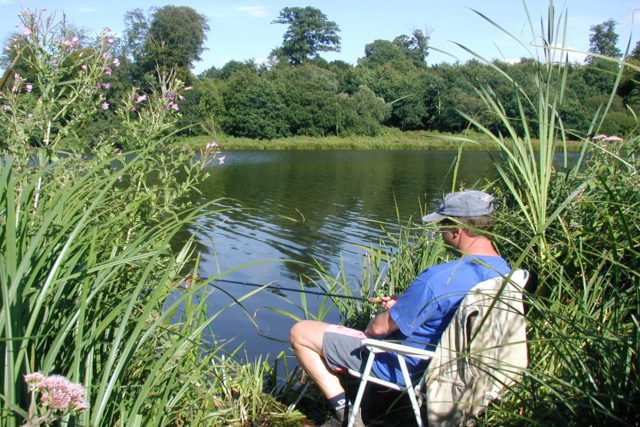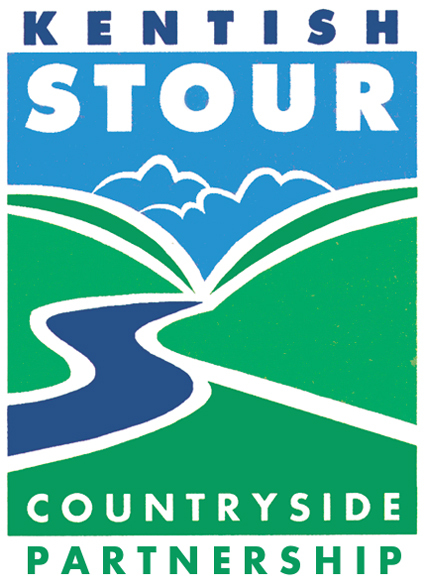Fishing
The sections below outline regulations and guidelines for fishing on the Stour and point you towards the best places to fish.
Regulations

- Course (freshwater) fishing on the River Stour is strictly seasonal. There is no coarse fishing allowed during the Close Season (15 March – 15 June). Maximum penalty £50,000.
- Anyone over 12 years of age must possess a valid rod licence issued by the Environment Agency. This must be available for inspection at all times whilst fishing otherwise prosecution may result. Maximum penalty £2,500.
- The Environment Agency’s South East Region rod fishing byelaws apply; see: https://www.gov.uk/government/publications/environment-agency-rod-fishing-byelaws-south-east-region
Guidelines
These guiding principles are aimed at sustaining fish stocks, protecting the environment and ensuring the health, safety and well-being of all river users, including anglers.
- DO return all fish unharmed to the river as quickly as possible. The use of keepnets to temporarily retain your catch – though not prohibited – is not encouraged. Fish removal can harm the natural balance of the river ecosystem and can add to the pressure that some threatened species are already under.
- DO use un-hooking mats when specimen fish are banked: unhooking is the aspect of fishing where fish are most likely to sustain damage. Fish care is vital from the moment you begin to land the fish through to its safe return to the river. Fish that are well looked after out of the water should grow, and reproduce, well in the water.
- DO NOT use crayfish of any species, whether alive or dead, (including any part of a crayfish) as bait. Native crayfish are rare and protected. Non-native crayfish species can spread crayfish plague, which can wipe out the native species.
- DO NOT take any fish for use as live bait unless the fish are retained at and used only in the water from which they were taken. Moving live baits between waters can spread fish diseases. Live-baiting, though not prohibited, is discouraged.
- DO NOT leave a rod and line with its bait or hook in the water, such that you are unable to take sufficient control of the rod.
- DO NOT block or otherwise obstruct riverside paths and cycle-ways.
- DO NOT light any fires on or close to the riverbank.
- DO be aware of other river users. Always take care when casting.
- DO keep a careful look out for overhead electric power lines and keep a safe distance away.
- DO follow the Check, Clean, Dry advice to prevent the spread of invasive species.
- DO report all instances of unauthorised angling, dead or distressed fish or incidents of pollution to the Environment Agency’s EA incident hotline on: 0800 80 70 60.
- DO take all litter home with you.
If anyone is seen fishing during the close season, or is believed to be fishing inappropriately, they should be reported to the Environment Agency’s Incident Hotline Tel: 0800 80 70 60 (24 hour service).
Rod licenses
- To fish the River Stour in Canterbury you need a fishing rod licence.
- Children under 12 don’t need a licence. However, if you take a child under 12 fishing and hold the rod or help hold it you must buy a licence for yourself.
- You must always carry your rod licence when you’re fishing or you could be prosecuted.
- If you are coarse fishing with three or four rods (four is the maximum allowed) then you will need to purchase a second licence.
- All the income received from rod licence sales is invested into maintaining, improving and developing fisheries.
You can be fined up to £2,500 for fishing without a rod licence.
It’s easy to buy your rod licence:
- on-line at environment-agency.gov.uk/rodlicence or
- at any Post Office.
Close season
Under the Salmon and Freshwater Fisheries Act, 1975 it is an offence to fish for coarse fish species between March 15th and June 15th (inclusive) on the River Stour. The ‘Close Season’ aims to protect fish stocks from the impacts of angling during the fish breeding season. MAXIMUM PENALTY £50,000.
If you see anyone fishing out of season call the EA incident hotline on: 0800 80 70 60.
Overhead power lines
Every year cases are reported of angling equipment contacting overhead electric power lines. Some have resulted in horrific burn injuries and even death. With the increasing development of fishing rods and poles, there is a risk of accidental contact with overhead electric power lines.
Remember:
- Overhead electric power lines are difficult to see at night and against a dark or light background.
- Lethal electric currents can pass through almost all fishing rods and poles.
- Overhead electric power lines are often uninsulated (bare) and can carry high voltages.
- Electricity can jump gaps.
- Overhead electric power lines on wood poles often look like telephone wires.
- Keep a careful look out for overhead electric power lines and keep away.
- Observe warning signs and instructions even in the car park or roadside.
- Unpack, set up and put away your rod or pole at the waters edge.
- Report any dangerous situation or near miss to the local electricity company.
Don’t risk being injured. Follow a few simple rules and stay safe
LOOK UP AND LOOK BEHIND YOU
Invasive species
Invasive non-native species can have a damaging impact on native plants, animals and ecosystems – by spreading disease, competing for habitat and food and direct predation.
Plants that grow profusely can block waterways while some animals can damage riverbanks – so they also affect economic uses of our environment and add significant management costs.
As a water user, you may unknowingly be helping to spread invasive species from one water body to another in equipment, shoes and clothing.
Help stop this happening by following three simple steps: Check, Clean, Dry.
Check your equipment and clothing for living organisms. Pay particular attention to areas that are damp or hard to inspect.
Clean and wash all equipment, footwear and clothes thoroughly. If you do come across any organisms, leave them at the water body where you found them.
Dry all equipment and clothing – some species can live for many days in moist conditions. Make sure you don’t transfer water elsewhere.
Fishing on the River Stour in Canterbury
In the late 1980s Canterbury City Council began a process of opening up the riverside corridor in the city to people. Today, access paths for walking and cycling follow the twists and turns of the river as it flows through the various parks and gardens of the city. As a consequence, the riverside routes are now very popular and well used by everyone.
The river itself is currently home to three punt and boat companies with a canoe company also looking for an operational base.
Given this situation the river in the centre of Canterbury is not best-suited to fishing.
Fishing on the Great Stour in central Canterbury, is now not seen as appropriate and is not encouraged for the following reasons:
- The city is a popular place for people – residents and visitors. The riverside access routes which pass close to the riverbank are particularly attractive to walkers, cyclists and joggers. The river itself is licenced for punts, rowing boats and canoes. There is a health and safety risk from casting lines with hooks across pathways.
- There is a complex arrangement prevailing whereby byelaws outlaw fishing in certain city council-owned parks and gardens. In other areas the riverside is in private ownership and the permission of the owner is required before fishing.
- The deeper pools close to mill races are characterised by high enclosing walls. Fish caught in these situations are difficult to land without causing distress and injury to the fish. Paths adjacent to these locations are often narrow and very popular with people. Fishing is not appropriate in this situation.
- The winding, narrow river corridor in most of the city is characterised by the presence of obstructions in the form of bankside trees, shrubs and overhead power lines. Empirical evidence suggests anglers are more likely to snag fishing lines in this context compared to more open countryside. Discarded fishing line and hooks represent a hazard to wildlife, particularly waterfowl, bats and other terrestrial mammals.
- Regular fishing from the same position may result in food and bait being discarded on the bank. This is not only untidy in appearance but is known to attract vermin. In an urban context this can quickly escalate into a serious issue.
- Fluctuating water levels, coupled with the obstruction of weirs, mean fish in the urban reaches of the river are often under stress. Fishing in such circumstances can exacerbate the situation.
- Fish in the Stour are under pressure from many factors. We would like to promote the city centre as a safe refuge for fish; a place from which they can spread out to improve the overall sustainability of the fish population throughout the river.
- The river margins in the city are increasingly coming under pressure from invasive plant species such as Japanese Knotweed (Fallopia japonica) and Himalayan Balsam (Impatiens glandulifera). Anglers who disturb marginal vegetation may inadvertently contribute to the spread of these potentially harmful species.
To conclude, the River Stour running through the centre of the city is not managed as a fishery and the river is not best-suited to the activity of fishing.
Those wishing to fish the River Stour are encouraged to join the Canterbury and District Angling Association. The Association provides nine miles of fishing from Fordwich to Plucks Gutter on both banks, with car parking at several points.
There are also numerous commercial fisheries within easy reach of the city. Those with a passion for angling, or just pursue fishing as a casual pastime, are encouraged to seek out alternative venues to those in the city (see below).
Where else to fish in the Canterbury area
Canterbury and District Angling Association
Sandwich & District Angling Association
Longshaw Fishery, Sturry
Email: longshawfishery@btinternet.com
Wantsum Angling Association
E-mail: info@wantsumangling.co.uk
Fishing on the River Stour in Ashford
As on any other river, fishing the River Stour in Ashford requires the angler to have an up to date rod license and to abide by the close season and other regulations. See Regulations and Guidelines for more information.
On private land, you also have to have the landowner’s permission in order to fish.
Much of the riverside land in Ashford is owned by Ashford Borough Council and free fishing in the river is allowed by the council in these areas. See the Ashford Green Corridor page for information on council owned parks and green spaces along the river.
The exception to this is where fishing rights are held by a club or society. Ashford Angling Society have rights to fishing on stretches of the river in the Willesborough/Conningbrook area – visit the Ashford Angling Society website or download this PDF below to see a map.
Ashford Angling Society also hold fishing rights on Singleton Lake.
Where else to fish in the Ashford area
In addition to the River Stour there are many lakes and other water bodies used for fishing in the Ashford area.
Maidstone Victory Angling Society
Stanhope Angling Society:
PO Box 324
ASHFORD
TN23 5EZ
